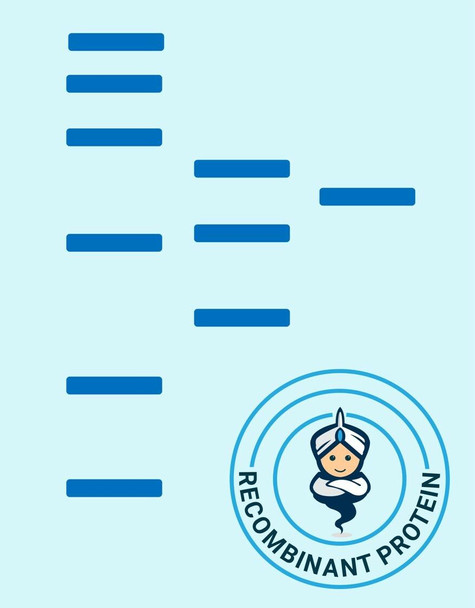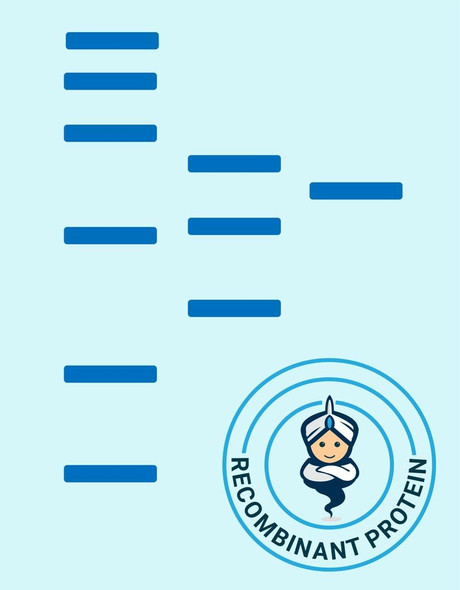Description
| Product Name: | Human ORM1 Recombinant Protein |
| Product Code: | RPPB4347 |
| Size: | 10µg |
| Species: | Human |
| Target: | ORM1 |
| Synonyms: | Orosomucoid 1, ORM, AGP1, OMD 1, AGP-A, alpha-1-acid glycoprotein 1, ORM1. |
| Source: | Human pooled serum |
| Physical Appearance: | Filtered White lyophilized (freeze-dried) powder. |
| Formulation: | ORM1 protein filtered (0.4�m) and lyophilized in 0.5 mg/ml in 20mM TRIS and 50mM NaCl, pH 7.5. |
| Solubility: | It is recommended to add deionized water to prepare a working stock solution of approximately 0.5 mg/ml and let the lyophilized pellet dissolve completely. Product is not sterile! Please filter the product by an appropriate sterile filter before using it in the cell culture. |
| Stability: | Store lyophilized protein at -20°C. Aliquot the product after reconstitution to avoid repeated freezing/thawing cycles. Reconstituted protein can be stored at 4°C for a limited period of time; it does not show any change after two weeks at 4°C. |
| Purity: | Greater than 95.0% as determined by SDS-PAGE. |
| Amino Acid Sequence: | QIPLCANLVP VPITNATLDQ ITGKWFYIAS AFRNEEYNKS VQEIQATFFY FTPNKTEDTI FLREYQTRQD QCIYNTTYLN VQRENGTISR YVGGQEHFAH LLILRDTKTY MLAFDVNDEK NWGLSVYADK PETTKEQLGE FYEALDCLRI PKSDVVYTDW KKDKCEPLEK QHEKERKQEE GES |
The acute phase plasma protein ORM1 synthesized by the liver mediates the interaction between blood cells and endothelial cells. In addition, together with haptoglobin and C reactive protein, ORM1 regulates the extravasation of the cells through infection and inflammation. Expression of ORM1 is induced by acute-phase stimulatory mediators such as bacterial lipopolysaccharides.
The Human Orosomucoid 1 produced from Human pooled serum has a molecular mass of 21.56kDa (calculated without glycosylation) containing 183 amino acid residues.
| UniProt Protein Function: | ORM1: Functions as transport protein in the blood stream. Binds various ligands in the interior of its beta-barrel domain. Also binds synthetic drugs and influences their distribution and availability in the body. Appears to function in modulating the activity of the immune system during the acute-phase reaction. Belongs to the calycin superfamily. Lipocalin family. |
| UniProt Protein Details: | Protein type:Secreted; Secreted, signal peptide Chromosomal Location of Human Ortholog: 9q32 Cellular Component: extracellular space; extracellular region Molecular Function:protein binding Biological Process: regulation of immune system process; transport; acute-phase response; inflammatory response |
| NCBI Summary: | This gene encodes a key acute phase plasma protein. Because of its increase due to acute inflammation, this protein is classified as an acute-phase reactant. The specific function of this protein has not yet been determined; however, it may be involved in aspects of immunosuppression. [provided by RefSeq, Jul 2008] |
| UniProt Code: | P02763 |
| NCBI GenInfo Identifier: | 112877 |
| NCBI Gene ID: | 5004 |
| NCBI Accession: | P02763.1 |
| UniProt Secondary Accession: | P02763,Q60590, P02764, |
| UniProt Related Accession: | P02763 |
| Molecular Weight: | |
| NCBI Full Name: | Alpha-1-acid glycoprotein 1 |
| NCBI Synonym Full Names: | orosomucoid 1 |
| NCBI Official Symbol: | ORM1�� |
| NCBI Official Synonym Symbols: | ORM; AGP1; AGP-A; HEL-S-153w�� |
| NCBI Protein Information: | alpha-1-acid glycoprotein 1 |
| UniProt Protein Name: | Alpha-1-acid glycoprotein 1 |
| UniProt Synonym Protein Names: | Orosomucoid-1; OMD 1 |
| Protein Family: | ORM1-like protein |
| UniProt Gene Name: | ORM1�� |
| UniProt Entry Name: | A1AG1_HUMAN |










